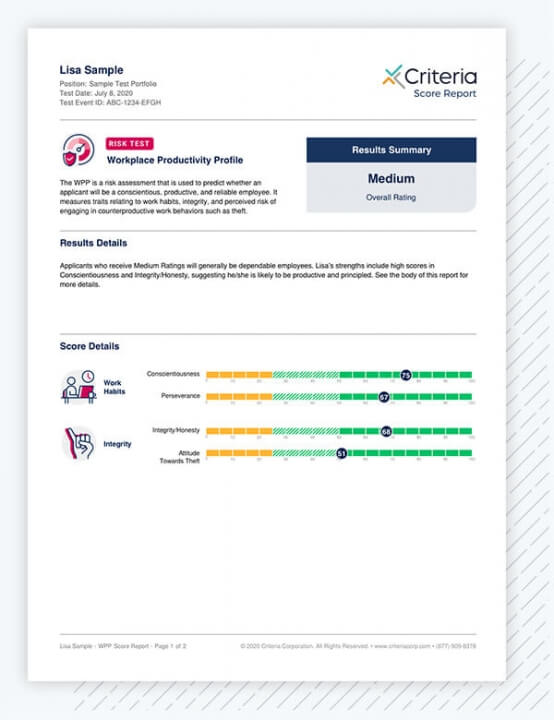Workplace Productivity Profile (WPP)
Measures:
- Conscientiousness
- Productivity
- Reliability
- Rule-adherence
Recommended for:
- Manufacturing
- Healthcare
- Retail Associates
- Field Service Technicians
- Janitorial Services
- And many more

Test Description
The Workplace Productivity Profile (WPP) is a risk assessment that is used to help predict whether an individual will be a conscientious, productive and reliable employee. It is used primarily for entry-level positions where rule adherence and trustworthiness are of primary importance. Like other integrity tests, the WPP can be used to predict overall performance as well as to screen out candidates judged to be more prone to possible disciplinary problems. The WPP measures four traits: Conscientiousness, Perseverance, Integrity/Honesty, and Attitudes towards Theft and Fraud. The first two traits (Conscientiousness and Perseverance) relate to a person's likely work habits. The latter two (Honesty and Attitudes towards Theft) relate to a person's integrity and perceived risk of engaging in counterproductive work behaviors (CWBs) such as theft, time-wasting, and fraud.
The WPP is used to help predict the likelihood of a wide range of outcomes ranging from general reliability and rule-following to risk for counterproductive work behaviors such as theft or fraud. As such, while it can be used for many positions it is of particular utility for employers screening entry-level employees where attendance, trustworthiness, and work ethic are of great value. Because of its emphasis on trustworthiness and rule adherence, the WPP is particularly popular with employers screening for positions where employees will be handling cash or inventory, or working in a client's home or business. The WPP is used widely as a selection instrument for positions such as retail store associates, cashiers, home health care aides, production workers, field service technicians and security guards, as well as a wide range of other entry-level positions.
The WPP consists of 50 self-report items and typically takes about 7 minutes to complete. An internal "faking" scale measures the extent to which a candidate is exaggerating strengths or minimizing weaknesses - and the scores of those applicants are automatically adjusted when appropriate.
Intended Use and Legal Compliance
The WPP can be used to help predict the likelihood of a wide range of outcomes including performance, general reliability and rule-following, and risk for counterproductive work behaviors such as theft or fraud. While it can be used for many positions it is of particular utility for employers screening entry- and mid-level employees where attendance, punctuality, work ethic and trustworthiness are valued, and is particularly popular for positions where employees will be handling cash or inventory, or working in a client's home or business.
It is estimated that employee theft costs U.S. businesses between $15 and $25 billion per year, and as a result about 40% of U.S. employers use integrity tests as part of their employee screening process. The WPP, like other integrity tests, has been shown to have no adverse impact on protected minority groups. There are no federal prohibitions on the use of integrity tests; however, the state of Massachusetts prohibits the use of any written assessment of honesty for hiring purposes, so the WPP should not be used in MA. The state of Rhode Island prohibits using integrity tests as the primary basis of employment decisions; users in RI should consult their legal counsel before using the WPP.
Score Reports
Each individual is given a percentile ranking for each of the four traits, as well as an Overall Rating of High, Medium, or Low, based on a combined score derived from the four individual trait scores. An internal "Self-enhancing scale" is used to adjust scores up or down in the event that the test detects unusually positive or negative response styles. In extreme cases of self-enhancing, the test will also be flagged as a potentially invalid result. Score reports also contain brief text descriptions for each of the four traits, and provide information as to how a candidate's score in individual traits may affect job suitability.
Standardization Sample
Norms for the WPP were developed using a sample of 1,107 individuals. The sample was made up of adults aged 18 and older, including both incumbents and job applicants. These individuals were being assessed for employee selection and/or benchmarking purposes, and represented a sample of individuals from over 50 companies, in an extremely broad and diverse range of positions.
Languages Offered:
- English (US) - Default
- Portuguese (Brazilian)
- Spanish (Latin American)
